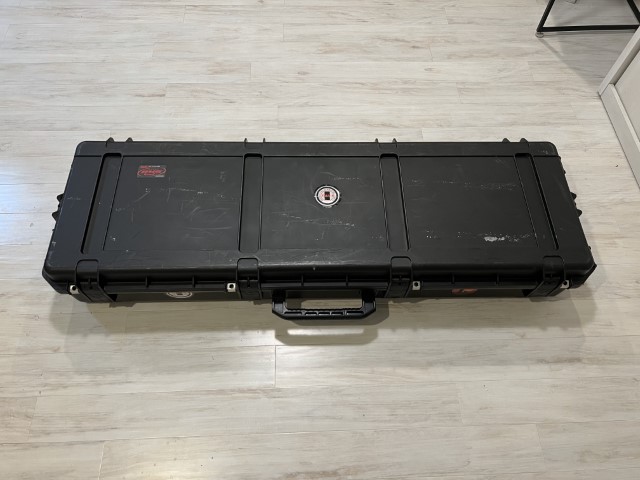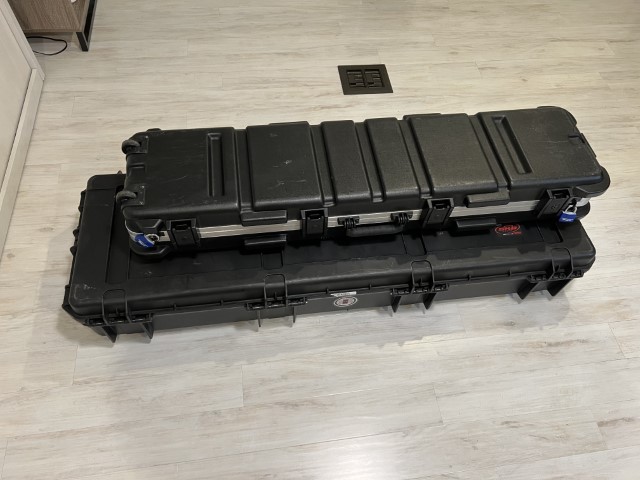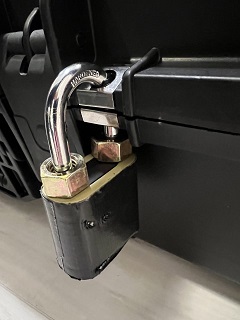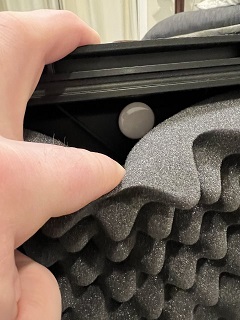If you transport guns via your checked baggage when flying, you know the requirements are pretty specific for transporting any firearm – hard case, locked, checked at TSA. Adding to these basic requirements, you’ll want to consider the following attributes:
Is the case durable enough to:
- Endure careless baggage handlers dropping it?
- Brush off impacts from shifting piles of luggage?
- Survive a drop from the moving luggage cart?
Can it handle the environment by:
- Accommodating changing air pressure? [yes, a 737 has a pressurized baggage compartment, but that system is only designed to keep pressure lower than about 8000 ft. And you may not always be in a plane with a pressurized cargo compartment.]
- Protecting the contents while lying exposed on a rainy, dirty tarmac or airstrip?
Is it secured by:
- Multiple locking points?
- Allowing you to use your own locks?
Finally, is the case going to protect its contents by offering enough interior space for the item and sufficient padding?
Pelican is Just Short of the Mark
Pelican-type cases and equivalents are usually what we think of for this. They’re made of high-strength plastic, are lockable, have a dust seal, and accommodate pressure changes. Unfortunately, most of these cases are too short if you’re moving the older pre-98 guns. For example, the longest case sold by Pelican, their 1755 Air Long Case, offers only 55″ of interior room. A Springfield Model 1868 or ’73 is 52″ long, leaving only 1.5″ of foam on the ends of the 9 lb. rifle. A Model 1863 is 56″, and let’s not even talk about that Kentucky muzzle loader.
Let me say, I’m not associated with any of these case manufacturers, nor do I have any sort of affiliate program that would allow me any profit off recommending their products. I’m just telling you about my experience.
How Long Do You Need?
I think about this in terms of how much foam I want protecting all sides of the muzzle and butt stock of my gun: top, bottom, and particularly the ends. I can’t imagine why I’d want less foam protecting the ends of the gun than I have above or below it.
Foam suitability is measured in density and firmness: how much the foam will compress (firmness) and then how long it’s going to survive being subjected to those pressures over time (affected by density). There’s an industry standard measurement out there called ILD or Indentation Load Deflection, which measures how much weight it takes for an 8″ diameter circular plate to compress a 15″x15″x4″ piece of foam by 25%.
Here’s a very boring video to give you the idea:
The standard dimensions of the sample and the indenter are important for a standardized ILD number because foam performance changes with thickness. For instance, if a 4″ piece of foam requires 35lbs to compress it by 1″, how would that change if the piece of foam was only 2″ thick? Well, the ILD will go down with foam thickness, and by how much depends on many factors including foam density, material, humidity, temperature, etc. Now what happens if the indenter isn’t an 8″ diameter plate, but is an irregularly shaped butt of a rifle, or a .75″ OD muzzle?
I don’t know, and I don’t care enough to dig beyond these basics of foam dynamics. My practice is to judge this by instinct taking into consideration the weight of the gun(s). My instinct is that I want more than 1.5″ of foam on either end of my gun while it’s being thrown on, off, and about airplanes.
So What Are My Options?
I recently travelled to Tulsa, Oklahoma for the Wanenmacher gun show and wanted to bring a case that would offer plenty of padding on the ends of a rifle and hold multiple rifles. I wanted something that would give me at least two inches of foam, preferably three at either end of the gun, with a gun assumed to be about 52″ long. So that means I want something greater than or equal to 56″ long. Just outside the 55″ length of most cases.
I settled on the SKB i-Series 6018. It’s an injection-molded case with an interior length of just under 60″. The thing is a monster though. Not only is it longer than your typical rifle case, it’s also a lot wider with an interior width of 18″.

To give you some idea of scale, here it is with an SKB 5009 double rifle case sitting on top of it. A friend laid up five rifles in the 5009, laid in butt to muzzle, vertically, in socks with minimal padding in between. It weighed about 75 lbs and was a horror to drag around. Imagine the damage you could do with the 6018. By now, I’m sure you can decipher how the model number relates to the interior dimensions.

The 6018 is large, but it still is within the oversize baggage limits on size and weight restrictions. It takes locks with a 5/16″ shackle diameter.
About Locks
So with gun cases you don’t have to use TSA locks. The TSA now allows you to use them with cases (they used to be forbidden entirely) but considering anyone can buy or 3D-print a set of TSA master locks for cheap, a TSA lock simply amounts to an expensive screw clasp. I secured each locking point on the 6018 with a combination padlock because I don’t like the risk of carrying keys around with me. If you lose your keys while travelling – and I’ve seen it happen – you’re screwed: time for a trip to Home Depot to buy bolt cutters and new locks. Yes, combo locks can be broken into relatively easily as well, but it requires next level skills or better compared to a TSA lock, and certainly more time.

There are six locking points, so this also adds a noticeable amount of weight to your case. You want to use every point because the plastic on these cases is relatively thin and flexible in such long slabs, making it prone to being pried open. Be sure to get the shortest shackle you can find. A long shackle will still allow the case to be opened enough that a hand could potentially reach in, or a gun shaken out of the opening. If your lock shackle is too long to prevent the lid from opening, you can place a couple hex nuts one each side of the shackle to take up the extra room and keep the lid from opening very widely at all. When my case was checked by the TSA agent in Alaska once, he commented that most people don’t know that trick and commended it, and I’d wager he sees a lot of rifle cases go through there.
Finally, I wrapped the body of each lock with black gorilla tape. This is purely cosmetic, but it really changes the look of your case, making the locks far less noticeable than when six brass bodies are standing out against the black case.
Tracking

I used an Apple AirTag to offer some traceability to my case. I do this with my luggage as well. It’s really nice to see where your luggage is relative to the plane you’re boarding. To secure it, I just used some strong double-sided tape within the lid of the case behind the top piece of egg crate foam. I’ve never been in an airport where I wasn’t able to see the location of my rifle case for more than about 10 minutes. The Apple AirTag uses everyone’s iPhone to report its location back to the mothership, and in the US, everyone in airports from the Starbucks to the tarmac have iPhones. Thankfully, I’ve never needed to use the AirTag to help the airport find a lost bag, but it would be highly useful in that circumstance.
Conclusion
The SKB 6018 is a great injection-molded case for transporting rifles probably up to 57″ without getting too creative in angling them to maximize the use of space. I’m still not aware of anything long enough from Pelican.
SKB even sells longer cases, up over 70 inches, along with full on rifle crates. There are other manufacturers like Gemstar that provide seriously heavy-duty cases, and shoddier companies that provide junk cases suitable only for automotive travel and which I think you’ll often find marketed to the muzzleloader community. For me, the SKB i-Series seems like a good product for a decent price.

